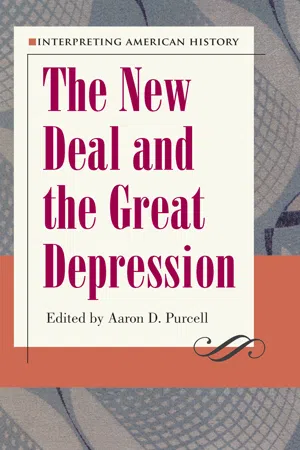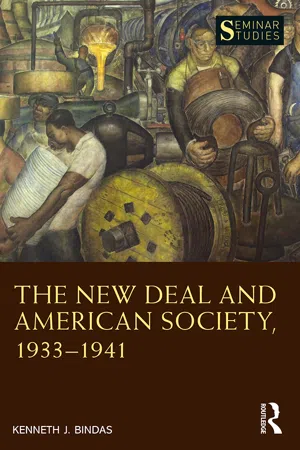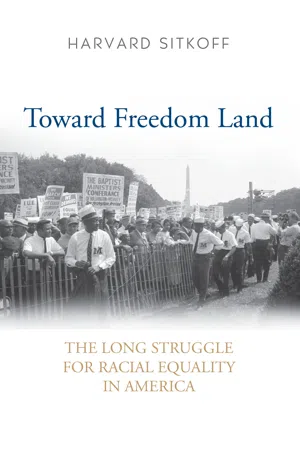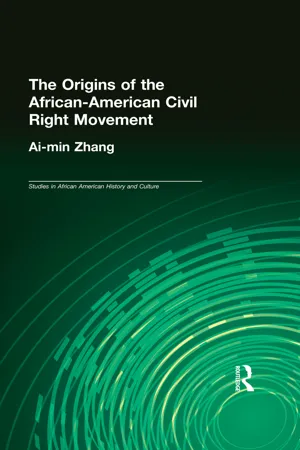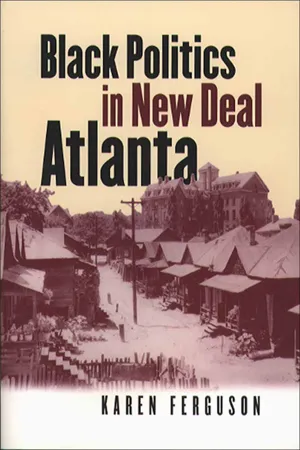History
African Americans and the New Deal
African Americans and the New Deal refers to the impact of President Franklin D. Roosevelt's New Deal policies on the African American community during the 1930s. While the New Deal aimed to provide economic relief, African Americans faced discrimination and unequal access to New Deal programs. Despite these challenges, the New Deal era saw some improvements in employment opportunities and the establishment of organizations advocating for civil rights.
Written by Perlego with AI-assistance
Related key terms
8 Key excerpts on "African Americans and the New Deal"
- Aaron D. Purcell(Author)
- 2014(Publication Date)
- The Kent State University Press(Publisher)
PART IIThe Fringes of the New Deal
Passage contains an image
CHAPTER EIGHT
African Americans and the Politics of Race during the New Deal
GLORIA-YVONNE WILLIAMS
The New Deal marked a pivotal moment in the African American struggle for equality and justice. Franklin D. Roosevelt’s New Deal introduced an expanded notion of democracy that transformed American social policy and provided a medium for African Americans to challenge existing racial boundaries. As a progressive Democrat, Roosevelt presented the New Deal as a way to serve the American people regardless of race, creed, or cultural background. In 1933, Roosevelt described his “new national administration” as one that would “restore the confidence” and “bring about governmental action to mesh more with the rights and the essential needs of the individual man and woman.”1 By the mid-1930s the New Deal created economic and political opportunities for African Americans through its policy of inclusion, which at that time was a fundamental step toward gaining recognition of their civil and political rights.African American leaders and activists embraced the New Deal’s reformist agenda as a vehicle to challenge racial inequities throughout government and society. In the 1940s, African American journalists Roi Ottley and Henry Moon viewed the political agency of African American leaders and activists as critical to the advancement and recognition of their full citizenship. Not since Reconstruction had African Americans been given the opportunity to participate in government reforms. Political scientists Minion K. C. Morrison and Richard Middleton IV acknowledged that “[t]he New Deal offered by Franklin Roosevelt is regarded as the first fundamental shift in African American representation.”2- eBook - ePub
- Kenneth J. Bindas(Author)
- 2021(Publication Date)
- Routledge(Publisher)
The combined activity of the 100 Days legislation highlights the many compromises FDR needed to make to satisfy the multi-dimensional aspect of not only the Democratic party but the country as a whole. The party included white southerners who did not want any challenge to Jim Crow segregation, northeast banking and business people fearful of federal takeover and control, midwestern farmers concerned about the demise of their way of life, Great Lakes industrialists concerned about labor unrest, westerners worried about being left behind and ignored by an eastern establishment, as well as a myriad of other groups and areas worried that the crisis of the day was simply too much for the country to recover from. This first New Deal seemed to have something for everyone.Almost everyone. The New Deal and FDR’s activity regarding African Americans during this early phase was poor at best, given that in industrial areas like Detroit, Chicago, and Philadelphia the unemployment rate ran as high as sixty percent. FDR was unwilling to come out in favor of advancing Civil Rights and equality and often substituted his wife Eleanor or other key advisors to stand in for him at events or for comments. FDR felt he had to walk a tightrope regarding the New Deal and its push for racial equality. The Democratic party was a monolithic block throughout the white South and its leaders were ardent segregationists and the idea of using federal power to challenge their racist system would have weakened FDR’s position and ability to get legislation through the Senate. Also, African American voters, until the election of 1932, had been historically Republican. This election was the first time Black voters switched from the party of Lincoln to FDR and so they lacked a clear and focused voice within the party. Perhaps another explanation for the lack of concern for this group of Americans stems from the fact that the New Deal, in large measure, with its advocacy on consumption and the marketplace, was designed to enhance or build up the middle class, not to reform the economic inequality evident in the urban or rural poor, or even to rescue those marginalized by the ravages of capital. FDR did recognize the increasing power of African Americans within the party and formed what was called the Black Brains Trust in 1933 through the Federal Council of Negro Affairs and with the influence of NAACP chair Joel Spingarn and the interest of the Julius Rosenwald Fund. Serving as informal advisors, and with the support of the First Lady, Hopkins, and former Chicago NAACP president Ickes, the group encouraged the president to recognize the unique issues facing the nation’s African American population which would lead, in the second incarnation of the New Deal in 1935, numerous key appointments including Lawrence Oxley, Mary McLeod Bethune - eBook - ePub
Toward Freedom Land
The Long Struggle for Racial Equality in America
- Harvard Sitkoff(Author)
- 2010(Publication Date)
- The University Press of Kentucky(Publisher)
Certainly no racial issue or matter had greater priority for blacks in the 1930s than the opportunity to earn a living or to receive adequate relief. The Great Depression devastated Afro-Americans, who were disproportionately mired in farm tenancy or who were the “last hired and first fired” in industry. At the bottommost rungs of the economic ladder, no group was in greater need of governmental assistance simply to survive. Accordingly, every civil rights organization and Afro-American leader scrutinized the various New Deal programs for their material effect on blacks. They found much to condemn. Blacks were never aided to the full extent of their need. New Deal legislation and local administration often resulted in discrimination against blacks or their exclusion from benefits. And, at times, the New Deal augmented the educational, occupational, and residential segregation of Afro-Americans.However much blacks hoped for a new deal of the cards from Roosevelt, they found the deck stacked against them. The heritage of black poverty and powerlessness brought them into the Depression decade without the wherewithal to overcome at the local level those insisting that they remain the lowest social class or to prevail over their opponents at the national level in a political system granting benefits mostly on the power of the groups demanding them. Largely due to the measures taken by southern state legislatures at the turn of the century to disenfranchise blacks, they could do little to lessen the president’s dependence for New Deal legislation and appropriations on the white southerners who held over half the committee chairmanships and a majority of the leadership positions in every congressional session during the thirties. The very ubiquity of the worst depression in American history, moreover, limited the possibility of a major New Deal effort to remedy the plight of blacks. Hard times defined Roosevelt’s mandate and kept the pressure on the New Deal to promote the economic recovery of middle-class America rather than to undertake either the long-range reform of the structural bases of poverty or to engage in a protracted effort to vanquish Jim Crow. In addition, the traditions of decentralization and states’ rights further undermined the effort of blacks to gain equitable treatment from the New Deal. Despite the laudable intent of many Roosevelt appointees in Washington, those who administered the New Deal at the state and local levels, especially in the South, saw to it that blacks never shared fully or fairly in the relief and recovery projects. - eBook - ePub
Toward Freedom
The Case Against Race Reductionism
- Touré F. Reed(Author)
- 2020(Publication Date)
- Verso(Publisher)
Nevertheless, millions of African Americans benefited from New Deal initiatives—sometimes in greater proportion than their share of the general population, even if they were underrepresented in relation to their need. Blacks were just 10 percent of the total population, for example, but accounted for 20 percent of all individuals on welfare rolls. Several hundred thousand African Americans, likewise, acquired work through the Civilian Conservation Corps (CCC), the Public Works Administration (PWA) and Works Progress Administration (WPA), while quotas, intended to ensure proportional representation, gave many African Americans access to newly constructed public housing projects in the era before public housing was a vehicle for warehousing poor people. 7 Yes, the 23 percent of agricultural and domestic workers who happened to be black were, like their white counterparts, excluded from coverage under the NLRA, the FLSA, and the SSA. But African American industrial workers—such as the 500,000 blacks who comprised 8 percent of the Congress of Industrial Organizations’ (CIO) membership in 1945 8 —were covered by each of these pieces of legislation. There is no question that African Americans did not receive their fair share of New Deal programs—particularly in housing. But the now commonplace tendency to dismiss the Roosevelt administration’s crucial role in improving the material lives of millions of African Americans has obscured both the importance of the New Deal’s redistributive policies to blacks—who demonstrated their support for the administration with their votes—and the influence of New Deal liberalism over the scope of black political activism from the 1930s through the civil rights movement. New Deal Industrial Democracy and Black Civil Rights In 1978, historian Harvard Sitkoff’s A New Deal for Blacks laid the foundation on which a generation of civil rights scholarship would rest - Ai-min Zhang(Author)
- 2014(Publication Date)
- Routledge(Publisher)
hapter Three Crisis, Opportunity and the Growth of African Americans' Political ConsciousnessThe Great Depression, which started in 1929, swept the entire capitalist world, and the United States was hit heavily by it. African Americans, who were experiencing discrimination and oppression, were hit especially hard. Franklin D. Roosevelt, soon after he assumed the presidency, began his now famous "New Deal" program. "The Negro has been given a broader and more variegated front to defend and from which to push forward. This is the great import of the New Deal to the Negro. For almost the first time in the history of the nation the state has done something substantial in a social way without excluding the Negro."1 The program afforded the African Americans more comfortable circumstances and more opportunities and influenced their progress immensely. From then on, the sense of self-protection, the discipline of organization and the African American's zest for participating in politics all increased. The New Deal program can be seen as having stimulated the rise of the civil rights movement. In order to meet the serious crisis posed by the Depression, African Americans had to find solutions to many of their own problems, and this increased their ability and courage in the face of difficulties. African Americans were also experiencing their first real political participation, and they recognized the importance of this participation. They were active in the labor movement and various black organizations. They made their choice between the Democratic Party and the Republican Party, with most of them breaking away from the Republicans and turning to the Democrats.The African Americans Turned to the Democratic PartyAbraham Lincoln was a Republican and soon after his election to the presidency, the American Civil War began. The winning of the civil war by the North, under the leadership of the Republicans, made African Americans free in the law. It also meant that for the next seventy-five years, most African Americans were dedicated to the Republican Party. However, the end of the Civil War did not lead to a real political awakening of African Americans. After the war, most African Americans took a negative attitude toward both political parties, and their participation in politics was very weak. The global economic crisis of 1929-1933 created a new need for a sense of self-protection and inspired greater participation in politics by blacks. Various actions and policies of the Republican Party shook their loyalty to it, and in the mid-1930s, they turned to the Democrats. In so doing, they became a very important member in the new political coalition.- eBook - ePub
- Karen Ferguson(Author)
- 2003(Publication Date)
- The University of North Carolina Press(Publisher)
The New Deal's potential fueled the dreams of many members of Atlanta's black reform elite. Most basic, Georgia's New Deal administrators included African Americans at the center of their public welfare program, something that state and local Officials had steadfastly refused to do. Such recognition freed private black agencies from the burden of providing emergency relief, sponsored long-term black welfare goals such as the creation of public nursery schools, and, as we shall see in future chapters, even provided funds and lent federal prestige to projects sponsored by the black community. For most in Atlanta's black reform community, such acknowledgment of the black community's needs, let alone its existence, was a long overdue step in the road to full citizenship. Adequate income, housing, food, health care, and recreation were African Americans’ due, and the New Deal's implicit recognition of these rights provided an extraordinary boost to the long struggle for black civil rights. Organizations and reformers had long struggled privately for such basic recognition for black neighborhoods and citizens, but the New Deal brought these services to African Americans at a level only before dreamed of by black leaders.From the beginning, black reformers supported the New Deal enthusiastically, even though it threatened the autonomy and influence of Atlanta's voluntary black social-work community. The Neighborhood Union had already experienced in its unhappy dealings with the Community Chest the dangers of ceding control to white agencies in an effort to integrate into the larger reform community in the city. This threat certainly existed with federal intervention in Georgia and the different foci and emphases of the white social workers heading the federal machinery. Yet black reformers did not complain or voice concerns over these developments. For them, the potential threat posed by the New Deal was more than counterbalanced by the fact that federal relief agencies in Georgia hired black experts and included them in the administration of federal programs, within a social-work framework that matched their own ideology and program. These pioneer black bureaucrats, social workers, public-health nurses, adult education teachers, and black advisers became an integral part of the New Deal relief program in Georgia and brought the black reform elite in from the cold, thus fulfilling their decades-long dreams of incorporation. - eBook - ePub
- Lisa Krissoff Boehm, Steven Hunt Corey(Authors)
- 2014(Publication Date)
- Routledge(Publisher)
Whether or not Franklin Delano Roosevelt’s New Deal constituted a continuation of a natural cycle between conservative and progressive/ liberal eras, or a marked departure from the previous trajectory of American politics has been the subject of intense debate by political scholars since the 1930s. It is possible to consider the New Deal an extension of the populist and progressive trends of the late nineteenth and early twentieth centuries. Of course the progressive ideals had lain dormant or at least had retreated from the corridors of Washington, D.C. during the highly conservative era which preceded the stock market crash. Following World War I, known at the time as “The Great War,” the United States had undergone an inward-turning, conservative period. Xenophobic attitudes heightened during the 1920s, as we saw in the preceding chapter, leading to a growth in membership in the Ku Klux Klan and the enactment of anti-immigration legislation.Facing economic and social upheaval, American politicians turned once again to more liberal ideas. Some scholars and cultural critics read the New Deal as a vast departure from American political traditions. A subset of these academicians see the New Deal as radical in its approach, akin to the socialist trends sweeping Europe at the time and, for the more conservative-minded, far too close to the theoretical underpinnings of communism. Others, including the influential historian Richard Hofstadter, disagree. Hofstadter, who writes from the liberal tradition while still maintaining that the New Deal constituted a marked deviation from past policy, contends that the New Dealers considered their nation fundamentally broken in the 1930s, and that only sweeping actions by the federal government could remedy the nation’s weighty problems. Hofstadter, in his important work, The Age of Reform (1955), states that “The New Deal was different from anything that had yet happened in the United States: different because its central problem was unlike the problems of Progressivism; different in its ideas and its spirit and its techniques.”9 The scholarly disputes over understanding the period lay, as in most historical debates, not in what occurred during the period, but in how to trace the events back to the reasons for their occurrence, and to understand what they mean for those living in modern times. As historians Gerald N. Grob and George Athan Billias argue:When describing the operation of specific New Deal programs... the differences of opinion between historians tend to narrow sharply. Thus what the WPA [Works and Progress Administration], NRA [National Recovery Administration], and other federal agencies did is often not a subject of dispute. The issue that invariably leads to conflict is the intent of the participants. The controversy involves not the relief activities of the 1930s, to cite one instance, but whether or not the concept of federal relief undermined the cherished American ideas of individualism and liberty.10 - eBook - ePub
Social Solutions to Poverty
America's Struggle to Build a Just Society
- Scott Myers-Lipton, Charles C. Lemert(Authors)
- 2015(Publication Date)
- Routledge(Publisher)
They benefited when they received federal jobs from the WPA. For example, federal jobs in Cleveland reduced black unemployment from 50 percent to 30 percent, and New Deal projects built over 3,000 housing units for black residents. At the same time, New Deal agricultural policies harmed blacks as they lost jobs when land was forced out of production in order to boost prices. Also, more than 200,000 African Americans did participate in the CCC, but did so in mostly segregated camps. Agricultural workers and domestic servants were not included in the unemployment insurance and old-age pensions, as well as minimum wage laws and the forty-hour maximum workweek, which excluded two-thirds of all blacks from participating in these programs. In addition, the New Deal allowed the states to control many parts of the Economic Security Act, since racist legislators demanded that the system be state-based or they would not support it. The “separate and unequal” system that operated in the United States, particularly in the South, allowed the states to limit the amount of assistance to blacks. This inequitable state-based system is still in place today for unemployment benefits, workers’ compensation, and aid to dependent children. The state-based policy sets apart the United States as the only industrialized country that lacks a national insurance system. 37 As a result of racist practices in government and business, a group of African Americans began organizing a march on Washington, D.C., for jobs and racial justice. With the prospect of tens of thousands of people marching on the nation’s Capitol, Roosevelt relented and issued executive order 8802, which banned racial discrimination in the nation’s defense industries. For the first time, the threat of a march on Washington had produced immediate action by the federal government. With their goal reached, the committee sponsoring the march called it off. However, twenty-two years later, Phillip A
Learn about this page
Index pages curate the most relevant extracts from our library of academic textbooks. They’ve been created using an in-house natural language model (NLM), each adding context and meaning to key research topics.
